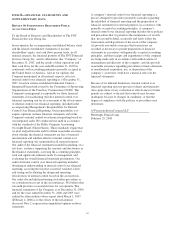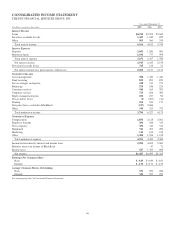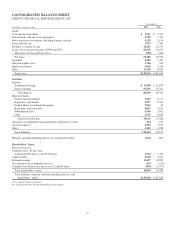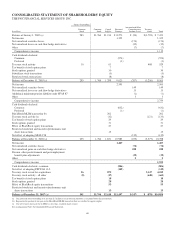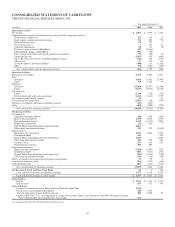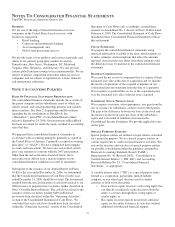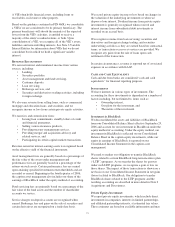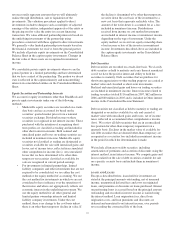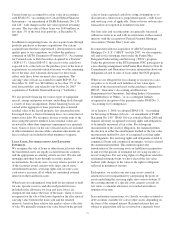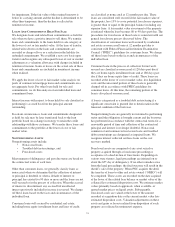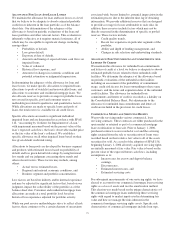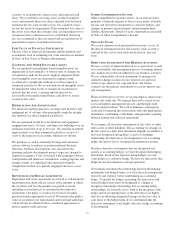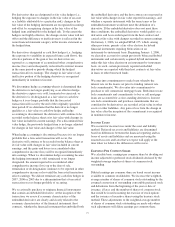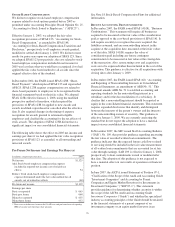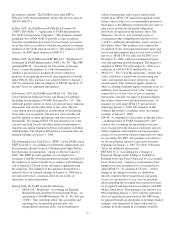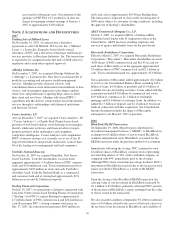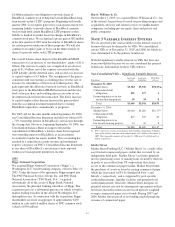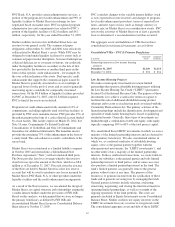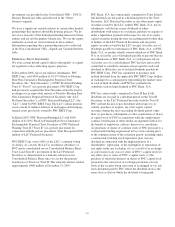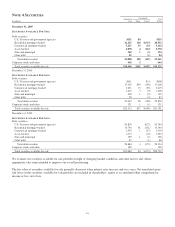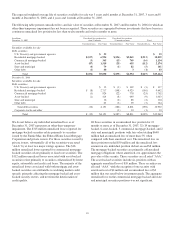PNC Bank 2007 Annual Report Download - page 80
Download and view the complete annual report
Please find page 80 of the 2007 PNC Bank annual report below. You can navigate through the pages in the report by either clicking on the pages listed below, or by using the keyword search tool below to find specific information within the annual report.A
LLOWANCE
F
OR
L
OAN
A
ND
L
EASE
L
OSSES
We maintain the allowance for loan and lease losses at a level
that we believe to be adequate to absorb estimated probable
credit losses inherent in the loan portfolio as of the balance
sheet date. Our determination of the adequacy of the
allowance is based on periodic evaluations of the loan and
lease portfolios and other relevant factors. This evaluation is
inherently subjective as it requires material estimates, all of
which may be susceptible to significant change, including,
among others:
• Probability of default,
• Loss given default,
• Exposure at date of default,
• Amounts and timing of expected future cash flows on
impaired loans,
• Value of collateral,
• Historical loss exposure, and
• Amounts for changes in economic conditions and
potential estimation or judgmental imprecision.
In determining the adequacy of the allowance for loan and
lease losses, we make specific allocations to impaired loans,
allocations to pools of watchlist and non-watchlist loans, and
allocations to consumer and residential mortgage loans. We
also allocate reserves to provide coverage for probable losses
not covered in specific, pool and consumer reserve
methodologies related to qualitative and quantitative factors.
While allocations are made to specific loans and pools of
loans, the total reserve is available for all credit losses.
Specific allocations are made to significant individual
impaired loans and are determined in accordance with SFAS
114, “Accounting by Creditors for Impairment of a Loan,”
with impairment measured based on the present value of the
loan’s expected cash flows, the loan’s observable market price
or the fair value of the loan’s collateral. We establish a
specific allowance on all other impaired loans based on their
loss given default credit risk rating.
Allocations to loan pools are developed by business segment
and products with estimated losses based on probability of
default and loss given default risk ratings by using historical
loss trends and our judgment concerning those trends and
other relevant factors. These factors may include, among
others:
• Actual versus estimated losses,
• Regional and national economic conditions, and
• Business segment and portfolio concentrations.
Loss factors are based on industry and/or internal experience
and may be adjusted for significant factors that, based on our
judgment, impact the collectibility of the portfolio as of the
balance sheet date. Consumer and residential mortgage loan
allocations are made at a total portfolio level based on
historical loss experience adjusted for portfolio activity.
While our pool reserve methodologies strive to reflect all risk
factors, there continues to be a certain element of uncertainty
associated with, but not limited to, potential imprecision in the
estimation process due to the inherent time lag of obtaining
information. We provide additional reserves that are designed
to provide coverage for losses attributable to such risks. In
addition, these reserves include factors which may not be
directly measured in the determination of specific or pooled
reserves. These factors include:
• Credit quality trends,
• Recent loss experience in particular segments of the
portfolio,
• Ability and depth of lending management, and
• Changes in risk selection and underwriting standards.
A
LLOWANCE
F
OR
U
NFUNDED
L
OAN
C
OMMITMENTS
A
ND
L
ETTERS
O
F
C
REDIT
We maintain the allowance for unfunded loan commitments
and letters of credit at a level we believe is adequate to absorb
estimated probable losses related to these unfunded credit
facilities. We determine the adequacy of the allowance based
on periodic evaluations of the unfunded credit facilities
including an assessment of the probability of commitment
usage, credit risk factors for loans outstanding to these same
customers, and the terms and expiration dates of the unfunded
credit facilities. The allowance for unfunded loan
commitments and letters of credit is recorded as a liability on
the Consolidated Balance Sheet. Net adjustments to the
allowance for unfunded loan commitments and letters of
credit are included in the provision for credit losses.
C
OMMERCIAL
M
ORTGAGE
S
ERVICING
R
IGHTS
We provide servicing under various commercial, loan
servicing contracts. These contracts are either purchased in the
open market or retained as part of a commercial mortgage
loan securitization or loan sale. Prior to January 1, 2006,
purchased contracts were recorded at cost and the servicing
rights retained from the sale or securitization of loans were
recorded based on their relative fair value to all of the assets
securitized or sold. As a result of the adoption of SFAS 156,
beginning January 1, 2006 all newly acquired servicing rights
are initially measured at fair value. Fair value is based on the
present value of the expected future cash flows, including
assumptions as to:
• Interest rates for escrow and deposit balance
earnings,
• Discount rates,
• Estimated interest rates, and
• Estimated servicing costs.
For subsequent measurements of our servicing rights, we have
elected to account for our commercial mortgage loan servicing
rights as a class of assets and use the amortization method.
This election was made based on the unique characteristics of
the commercial mortgage loans underlying these servicing
rights with regard to market inputs used in determining fair
value and how we manage the risks inherent in the
commercial mortgage servicing rights assets. Specific risk
characteristics of commercial mortgages include loan type,
75


